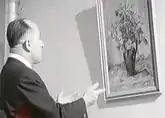Hans Bender
Hans Bender (1907 – 1991) was a German parapsychologist who specialized in promoting claims of poltergeists and clairvoyance.

| Putting the psycho in Parapsychology |
| Men who stare at goats |
| By the powers of tinfoil |
v - t - e |
Career
In 1933, Bender got his PhD in Psychology from the university at Bonn. From 1942 to 1944, he taught at the Paracelsus Institute and used the facilities to conduct research on woo such as astrology and dowsing. In 1950, he founded the "Institute for Frontier Areas of Psychology and Mental Health" in Freiburg. Although Bender claimed to hold a PhD in medicine, no one was able to find any record of this. Later, Bender would be impressed by the spoon bending tricks of Uri Geller and became a popular figure with the parapsychology-is-cool crowd. [1]
Clairvoyants!
Bender's favorite clairvoyant was the late Gerald Croiset of Holland. He credited Croiset with finding bodies of murder victims (which were never actually found). And he claimed that Croiset was able to predict who'd be sitting in chairs in the future.[2] Bender reportedly conducted a transatlantic "chair" test with Jule Eisenbud, the psychiatrist-turned-parapsychologist who believed Ted Serios' drunken trickery was totally paranormal.[3]
Poltergeists!
In 1965, Bender claimed that a 15-year-old retail store employee in Bremen was inadvertently focusing psychokinetic forces to inflict damage on the store's goods. Officials at the teenager's school said they found screws were loosened when the youth was nearby. Bender believed the young man surely had poltergeisty powers, but when he examined him in a laboratory with cameras running, sadly, no screws got loosened.
Rosenheim Poltergeist
The supposed jewel in Bender's crown is the 1967 case of the "Rosenheim Poltergeist". A lawyer's office in the Bavarian city was the subject of a months-long massive pranking, most likely orchestrated by management and some of the staff. Overhead lights and hanging paintings would seem to swing by themselves, furniture was found to be "mysteriously" moved, and the power company reported lots of electric current being used. Up to 6 phone calls per minute were logged to a local "talking clock" service (ZOMG, that's a call every ten seconds! No human could possibly accomplish that!) When copy machines leaked copier fluid, a "supernatural agent" was blamed. And it was claimed some unseen force had caused overhead fluorescent tubes to "unscrew themselves." (Anyone who's worked in an office with banks of fluorescent lighting may recall the standard practice of cutting down some of the unpleasant glare by slightly twisting some of the fluorescent tubes in their sockets while keeping them in place.) Bender set up video surveillance cameras. When they recorded a painting suddenly going askew, Bender was convinced he had irrefutable evidence of poltergeists.[4]
Bender got utility company officials, police and some local physicists to attest that they could not explain the phenomena, and proclaimed that a lovelorn 19-year-old office secretary was acting as a conduit for the "poltergeist". But when skeptical Viennese magician Albin "Allan" Neumann[5] visited the office, he discovered it was rigged with thin nylon threads attached to paintings, lights, and wall decorations. The law office promptly filed for a legal injunction to prevent Neumann from publicizing his discovery.[6]
External link
References
- Parapsychology: A Concise History by John Beloff
- Rumor has it Croiset also won the Guinness Record for "Most Useless Skill".
- Science Confronts the Paranormal Kendrick Frazier
- Hauntings and Poltergeists: Multidisciplinary Perspectives James Houran, Rense Lange
- Albin Neumann allaboutmagicians.com
- But he did anyway: "Falsche Geister, echte Schwindler" (Fake ghost, real swindler) by Neumann, Kramer, and Schiff, 1969. Zsolnay publishing.